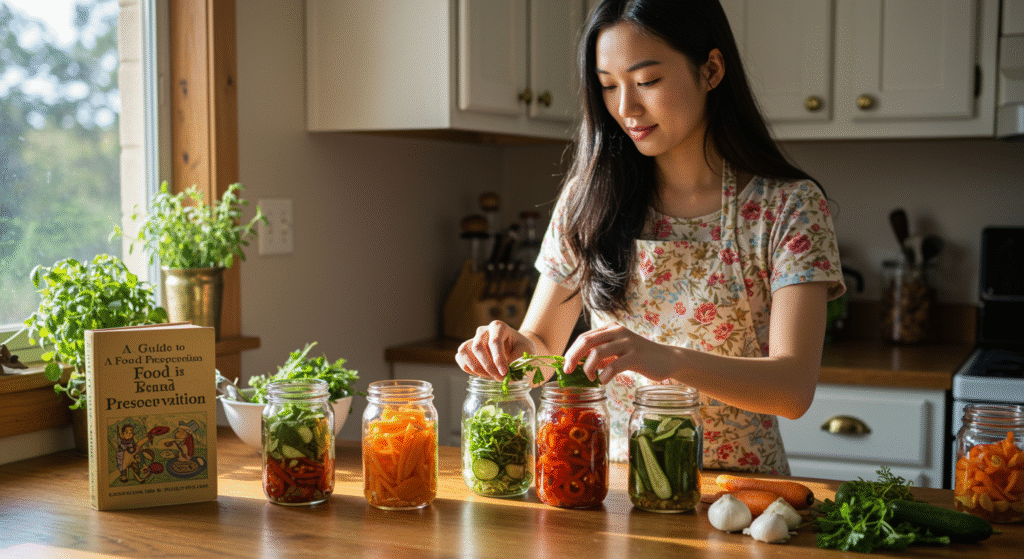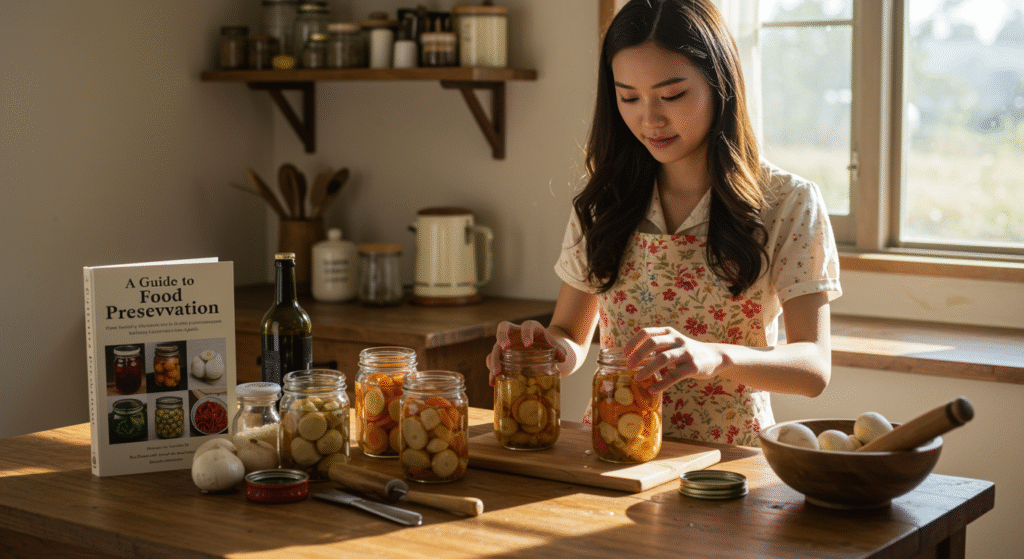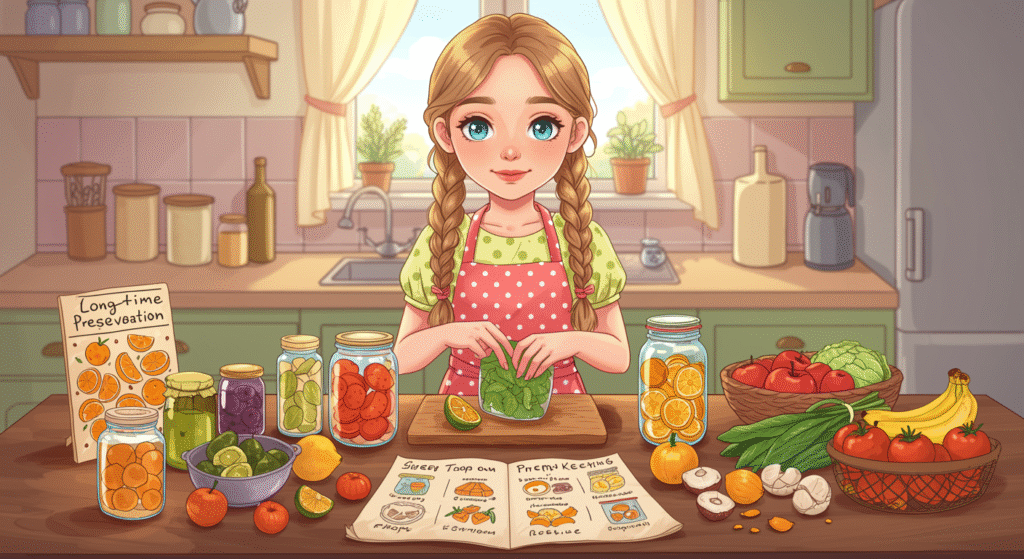
Whether you’re preparing for an emergency, stocking up for future use, or simply looking to reduce food waste, preserving food for long-term storage is a valuable skill. With the right techniques, you can ensure that your food remains nutritious and safe to eat for months or even years. Proper food preservation allows you to maintain a well-stocked pantry and save money while making sure your meals are always ready when you need them. Here are some of the most effective methods for preparing foods for long-time keeping.
1. Canning: Seal in Freshness

Canning is one of the oldest and most reliable methods for preserving food. By sealing food in airtight jars and processing them at high temperatures, canning kills bacteria and other microorganisms that could cause spoilage. It’s ideal for fruits, vegetables, meats, and sauces.
- How it works: Foods are packed into glass jars, and the lids are sealed tightly. The jars are then heated to a specific temperature in a water bath or pressure cooker to kill harmful microbes and create a vacuum seal.
- Best foods for canning: Tomatoes, berries, pickles, jams, and stews.
- Tip: Always follow tested canning recipes to avoid contamination and ensure the food is preserved safely.
2. Freezing: Lock in Freshness and Nutrients
Freezing is another popular method of food preservation. It works by slowing down the growth of bacteria, yeast, and molds, which would otherwise cause spoilage. Freezing helps retain the taste, texture, and nutritional value of most foods.
- How it works: Foods are placed in airtight containers or freezer bags to prevent freezer burn, which can affect the quality of the food. It’s important to ensure that food is frozen quickly and stored at a consistent temperature (0°F or lower).
- Best foods for freezing: Vegetables, meats, bread, and prepared meals like soups or casseroles.
- Tip: Blanch vegetables before freezing to preserve flavor, texture, and nutrients. Make sure to label everything with dates so you can use it before it loses quality.
3. Dehydrating: Removing Moisture for Extended Storage

Dehydrating food involves removing the moisture from the food, which prevents the growth of bacteria and mold. When done properly, dehydrated foods can be stored for months or even years. This method works by reducing the water content in food, which is necessary for bacterial growth.
- How it works: Foods are dried using a food dehydrator, an oven, or even by air-drying. The process removes most of the water, leaving behind only the solid nutrients. The food is then stored in airtight containers in a cool, dry place.
- Best foods for dehydrating: Fruits (apples, berries, bananas), vegetables (tomatoes, mushrooms, peas), herbs, and jerky.
- Tip: For best results, vacuum seal dehydrated foods in Mylar bags or glass jars to keep out air and moisture, which can shorten the shelf life.
4. Fermentation: Preserving with Probiotics
Fermentation is a natural preservation method that involves converting sugars into acids or alcohol, creating an environment that inhibits harmful bacteria. It’s also great for boosting the nutritional value of foods by adding beneficial probiotics to your diet.
- How it works: Foods such as vegetables, fruits, and dairy are fermented by adding beneficial bacteria or wild yeast to the food. The food is stored in airtight containers at room temperature until fermentation is complete.
- Best foods for fermentation: Sauerkraut, kimchi, pickles, kefir, yogurt, and kombucha.
- Tip: Use sterilized equipment and clean hands to avoid introducing harmful bacteria into your ferments.
5. Salt Curing and Smoking: Preserving with Salt and Smoke
Salt curing and smoking have been used for centuries to preserve meats, fish, and some vegetables. These methods work by drawing out moisture and creating an inhospitable environment for bacteria to grow.
- How it works: Salt curing involves rubbing salt onto meat or fish, which draws out moisture and prevents microbial growth. Smoking works by exposing food to smoke from burning wood, which helps to preserve food and add flavor.
- Best foods for curing and smoking: Bacon, ham, fish, and sausages.
- Tip: After curing or smoking, store preserved foods in a cool, dry place or refrigerate them to extend their shelf life.
6. Vacuum Sealing: Seal Food for Longer Freshness
Vacuum sealing removes the air from a bag or container and then seals it tightly to keep out oxygen, moisture, and bacteria. This method is especially effective when used in combination with other preservation techniques like freezing or dehydrating.
- How it works: Food is placed in a vacuum-seal bag, and the air is sucked out using a vacuum sealer machine. The bag is then sealed tightly, ensuring no air can enter.
- Best foods for vacuum sealing: Meats, vegetables, cheeses, and prepared meals.
- Tip: Make sure to double-bag foods like raw meat before freezing to prevent leakage and maintain quality.
7. Storing Grains, Nuts, and Legumes
Grains, nuts, and legumes have a long shelf life when stored correctly. To ensure they last for months or even years, it’s important to store them in airtight containers and keep them in a cool, dry place. Oxygen absorbers and vacuum-sealing can further extend their shelf life.
- Best foods for storage: Rice, beans, lentils, oats, quinoa, and dried nuts.
- Tip: Keep grains and nuts in airtight containers or Mylar bags, and consider adding oxygen absorbers to prevent spoilage.
Conclusion: Stock Up, Stay Prepared
Whether you’re preserving fruits from a summer harvest, stocking your pantry for winter, or preparing for emergencies, having a variety of preservation methods at your disposal is essential for long-term food storage. Canning, freezing, dehydrating, fermenting, and vacuum sealing can help you keep a wide range of foods fresh and accessible. With proper preparation, you can ensure that your food lasts for months, even years, and that you always have a nutritious meal ready when you need it